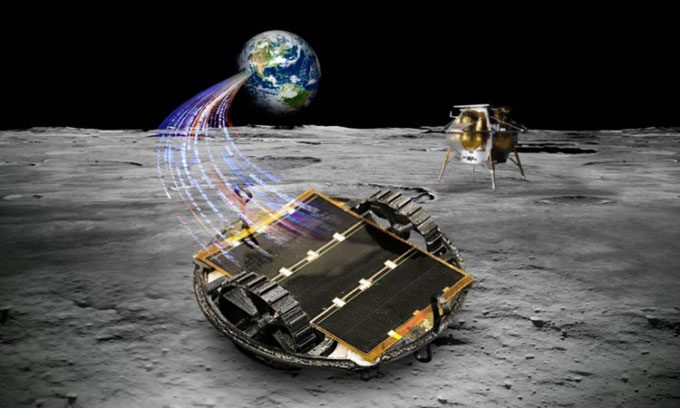Five robots resembling thin discs, measuring 12 cm in diameter with two wheels, are set to launch into space this year to study the surface of the Moon.
These five miniature robots are scheduled for launch in June as part of the Colmena project, where they will traverse the lunar surface and perform intricate measurements, Reuters reported on February 25. This marks the first time a scientific mission of this kind has been implemented.

Illustration of miniature robots operating on the Moon. (Photo: UNAM)
The army of miniature robots has been developed by a research team at the National Autonomous University of Mexico (UNAM) and will operate collectively like a swarm of bees. The Peregrine lander from the American company Astrobotic Technology will transport them from Earth, beginning a journey of approximately 386,000 km to the Moon.
The lander is expected to launch into space using the Vulcan rocket from the American company United Launch Alliance. If successful, this will be the first American lander to touch down on the Moon in nearly 50 years.
“This is a small mission for us to test the idea. After this, we will conduct other missions, first to the Moon and then to asteroids,” said Gustavo Medina Tanco, a scientist at UNAM and the project leader for Colmena.
Colmena means “beehive” in Spanish. During a visit to UNAM’s space instrument laboratory, the Colmena project team tested a launch device for the robots. The project involves 200 students from fields such as chemistry, mathematics, physics, and engineering.
The robots are constructed from stainless steel, titanium alloy, and high-quality aluminum designed for space missions. Each robot features two wheels and a body resembling a thin disc with a diameter of 12 cm. They can communicate with each other and with the command center on Earth.
Medina Tanco stated that they are equipped to collect lunar minerals that could be useful for future space mining. During the month-long mission, the army of miniature robots will conduct measurements of lunar plasma temperature, electromagnetic fields, and soil particle sizes for the first time.
Medina Tanco is very proud of the upcoming mission. “No one has ever done this, not just in Mexico. We can make a difference in technology and international collaboration, thereby forming important partnerships for mineral research or conducting other scientific discoveries,” he said.


















































